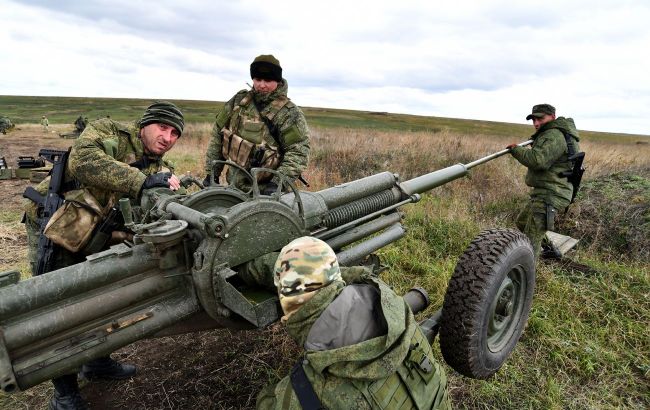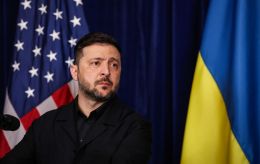Does Russia really have countless weapons stockpiles?
 The Russians may have thousands of weapons in their warehouses, but not all of them are in good condition (GettyImages)
The Russians may have thousands of weapons in their warehouses, but not all of them are in good condition (GettyImages)
Ivan Kyrychevskyi, an expert of the Defense Express Media & Consulting Company, shared his insight about the armed potential of the Russian Federation and whether Moscow really has bottomless reserves of war equipment.
In the context of assessing the quantity and condition of Russian weaponry, there remains a certain fog of war. It is difficult to pinpoint the source of the figure circulating in the information space, claiming that Russians still have 17,000 tanks in reserve. According to the International Institute for Strategic Studies' assessment "The Military Balance," as of the beginning of February 2022, Russians had only 10,000 tanks in storage, not accounting for the older T-55 and T-62 models, with 3,300 tanks of all types in active service.
Now, the same International Institute for Strategic Studies accounts for the possibility that Russians may have at most 5,000 tanks of all types in storage, including T-55 and T-62 models. According to the organization's data, they have approximately 2,000 tanks in active service. Colonel Serhii Cherevatyi, the Deputy Commander of the Eastern Military Communications Group, said that the enemy had deployed around 900 tanks in the Kupiansk and Lyman directions, which is half of what they have in active service.
Why can data about tanks stored in depots be misleading? Because not all Russian tanks were stored in airtight facilities, or hangars, with proper maintenance. According to Russian standards, to assemble one fully operational tank, you need to disassemble three. So, the figure that was recorded at the beginning of this year – 5,000 tanks in depots – may mean that the Russians can assemble 1,500-2,000 working tanks in addition to what they have now.
They do have the capability to restore their tank potential. According to information from open sources, the enemy at the Uralvagonzavod plant can manufacture 10-15 new T-90M Proryv (Breakthrough - ed.) tanks per month. This is Russia's primary tank factory with a workforce of 12,000 people, including contracted labor.
It is also believed that theoretically, Russians can modernize up to 50 tanks per month. For instance, they take old T-72B and T-80BV tanks from storage, not only repairing them but also equipping them with relatively modern equipment. Or they simply refurbish old Soviet tanks and send them to the front.
One could also separately consider the Russians' ability to repair their T-55 and T-62 tanks, which theoretically were supposed to be melted down. Only the 103rd armored repair plant in Transbaikalia can work on these tanks, with a production rate of up to 10 machines per month.
Therefore, if we sum up the potential for Russians to acquire up to 70 tanks of all types per month, it underscores that they are replenishing their tank arsenal much slower than the Ukrainian Armed Forces are depleting it.
On one hand, Russian tanks, even the very old ones, pose a nuisance to Ukrainian troops on the front lines because the enemy uses them for long-range shooting from concealed positions. They elevate the gun to a maximum angle and fire from a distance of several kilometers at Ukrainian positions, especially during rotations of our military units, when one unit leaves for rest and another arrives. Then the Russians started firing with tanks – imprecisely, but still causing problems for Ukrainian troops.
It is evident that a soldier in a trench, who may be vulnerable to fire even from an old T-55, isn't overly concerned about how many such tanks Russians can deploy. On the other hand, objective figures show that the enemy's tank numbers are gradually dwindling.
There is indirect evidence that the aggressor is experiencing a shortage of fully operational tank equipment for some active offensive actions. This is supported by the fact that in the Kupiansk direction, they dared not to use their tank units in the classical format when tanks are employed in an offensive role. Even though the reconstituted 1st Tank Army of the Western Military District of the Russian Federation, which was defeated in the Kharkiv region last year, is based there. Russians first began this practice in 1943 when they faced tank shortages and Soviet military leaders decided that it was better to send ill-prepared infantry into battle while conserving and sparing tanks.
When it comes to armored vehicles, there's an interesting story as well. If we consider BMP-1, BMP-2, and MT-LB, on paper, you could also reach a total of over 10,000 units in storage. However, it appears that the repairability of BMP-1 and BMP-2, even for Russians, leaves much to be desired. So, on paper and in satellite imagery, you can see this immense number of vehicles, but Russians prefer to unstore and use MT-LBs in battle. These vehicles have more accessible spare parts. In the 1990s, 2000s, and 2010s, these MT-LBs were in circulation on the civilian market in Russia. Plus, there are enterprises capable of repairing and restoring such vehicles.
So, to say that they have unlimited capabilities in terms of armored vehicles is not accurate. In fact, that's why the Russians, during any offensive operations now or during counterattacks in the south or near Bakhmut, still rely on the infantry, which is commonly referred to as cannon fodder. In other words, for another couple of years of war with such losses and at such an economical pace of armored vehicles, they will have enough. But beyond that, they risk running out completely.
Regarding artillery, it presents a more complex picture. At the beginning of this year, according to data from the International Institute for Strategic Studies, Russians may have had as many as 17,000 artillery systems of various types in storage. The question is how many of these are combat-ready and capable of firing. Interestingly, toward the end of last year, the enemy was forced to reactivate not the more modern artillery systems like D-30 howitzers or Msta-B from the 1980s but rather D-1 howitzers from World War II. These guns have found their way into various units of the Russian armed forces, including the 1st and 2nd Army Corps and the regular Russian military, as well as among the Wagner mercenaries.
Another factor to consider is the number of rounds fired applicable to all types of artillery systems. After firing 2500 rounds, the barrel needs to be replaced. The artillery systems stored by the Russians are not in pristine condition, they have seen some use.
The issue for us (Ukraine - ed.) is that Russians have a few hundred particularly dangerous self-propelled howitzers, the 2S7 Pion or 2S7M Malka, with a caliber of 203 mm stored in their arsenals. These were designed in the Soviet Union for tactical nuclear weapons. Russians are currently focusing on these howitzers because they have a firing range of up to 40 kilometers, which corresponds to the range of our NATO systems.
Another especially dangerous category of Russian self-propelled artillery units, a few hundred of which could also be brought out of storage, is the 2S4 Tyulpan. While their firing range is less than 20 kilometers, they have a caliber of 240 mm. Russians have used similar mortars to shell Azovstal, which they are now trying to target Ukrainian forces in the south with.
According to Russian statements, they are beginning to form new additional units around these two types of artillery systems. One division requires 18 artillery systems, and a battery consists of 6 artillery systems. Given the power of these artillery systems, Russian artillery poses a problem for Ukraine.
The adversary employs long-range Tornado-S systems, which are essentially upgraded versions of the Soviet-era Uragan systems, armed with guided rockets. This means that these Uragans can be easily taken out of storage. Assessing the actual reserves of the Russians regarding the reactivation of multiple-launch rocket systems (MLRS) is genuinely challenging. However, after Ukrainian forces successfully neutralized a significant portion of the enemy's tube artillery during counter-battery actions, Russians started replacing them with MLRS. So, the situation is twofold: in some aspects, they may be objectively weak and their strength may exist only on paper, but in other aspects, they can pose real problems for Ukraine.
When it comes to ammunition, the situation is also ambiguous. According to figures from Russian analysts, if they produced 12 million rounds of all types in 2022 (not only classical artillery shells but also rounds for BMP cannons and others), they will produce 7 million rounds this year, although the actual volume may turn out to be higher. At the same time, Western analysts are beginning to observe that the aggressor is attempting to compensate for this by improving the accuracy of their fire and increasing the production of Lancet guided missiles.
The main threat from Lancets is that they serve as a substitute for the artillery that was successfully destroyed by the Ukrainian Armed Forces. According to Deputy Chief of the General Staff of the Ukrainian Armed Forces, Brigadier General Oleksii Hromov, from the beginning of the large-scale invasion until mid-summer this year, the enemy managed to produce 900 such drones. In essence, that's about 1.5 Lancets per day.
They have primitivized the production of these UAVs. They use Soviet-era cumulative warheads, which are quite powerful. They also equip them with electric motors similar to those used in miniature remote-control airplanes, which cost around 300 euros on the markets in Czechia and Poland. It's paradoxical that the Lancet has a takeoff weight of 12 kg, yet they somehow attached electric motors designed for 5 kg miniature aircraft. One of the Lancets that was shot down near Bakhmut at the beginning of August this year was found to have such an electric motor.
One con of the Lancet is that it doesn't self-guide; it requires a separate UAV, the SuperCam, for target designation. It doesn't have its own electronics or camera for guidance, and it needs an additional reconnaissance drone for that purpose. However, this simplification allows Russians to potentially scale up the production of Lancets.
Even under sanctions, Russians can manufacture not only rockets but also aircraft. According to relatively relevant data for 2022, the Russian Air Force received 20 combat aircraft. In the context of what Ukrainian air defenses have managed to achieve, it may seem insignificant, as they downed 200 units by May 2022. On the other hand, there is information that Russians have already received at least 10 new aircraft such as Su-35 and Su-34 this year, and they plan to produce or refurbish a total of 40 military aircraft of all types (including the production of Yak-130 training-combat aircraft, which they have also started supplying to Iran, and the refurbishment of Tu-160 bombers).
We could debate on and on about how many tanks Russia can manufacture and repair per month. However, we can't compare this with Ukraine's capabilities because we keep such data classified. We can only rely on indirect sources and open data. For instance, we sometimes see Ukrainian military posts about conserved and modernized T-72 tanks, as well as very rare modifications of T-64 tanks, being in service alongside more modern Leopard 2 tanks.
This winter, Ukraine and Czechia, under a memorandum, agreed that Czech facilities would be used to refurbish conserved T-64 tanks. The only thing here is that these tanks were manufactured exclusively in Ukraine. So, when so-called Russian correspondents complain that we'll never run out of T-64 tanks – they have a valid point.
In addition, there is a certain amount of official military assistance announced by Ukraine's partners. However, the Ukrainian Ministry of Defense has said multiple times in the past that they also purchase weaponry from the state budget. If, for example, until 2021, we allocated a maximum of 2 billion dollars for new weaponry, our expenses for arms procurement have now increased several-fold.
Because there are no publicly available figures or official statements to work with, an illusion might arise that Ukraine is not doing anything. Nevertheless, Ukraine has a military-industrial complex capable of producing what's needed and making up for some of the lag in comparison to Russian capabilities. Everything that can be refurbished, everything that operates by the "moves and shoots" principle is supplied by the Ukrainian military-industrial complex.

